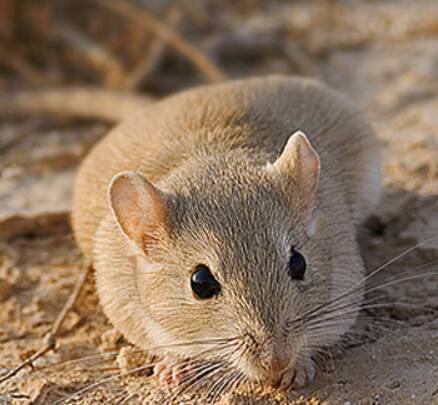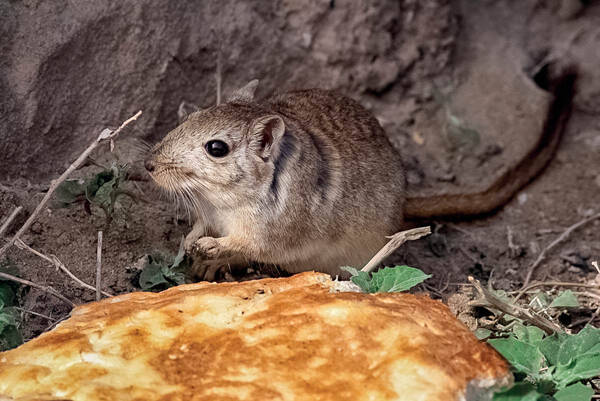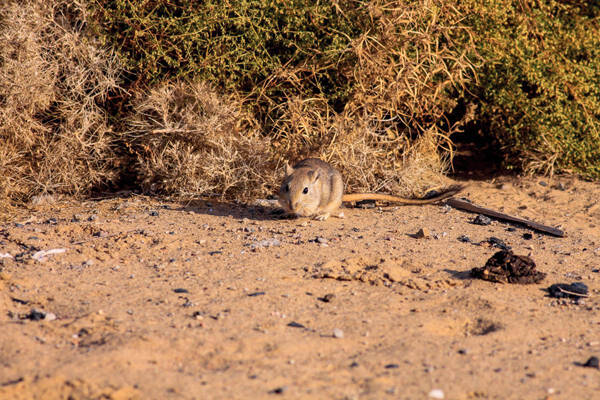Meriones erythrourus
IUCN
LCBasic Information
Scientific classification
- name:Meriones erythrourus
- Scientific Name:Meriones erythrourus,,Meriones libycus,Red-tailed gerbil
- Outline:Rodents
- Family:Rodentia Cricetidae Gerbil
Vital signs
- length:120-180mm
- Weight:
- lifetime:
Feature
It has a large and sturdy body, a gray-brown back, a gray hair base, a tail that is nearly the same length as the body, and the color of the tail is obviously different from the back color, being brown-yellow.
Distribution and Habitat
In China, it is only distributed in Xinjiang. Abroad, it is distributed in Saudi Arabia, Jordan, Iraq, Syria, Iran, Afghanistan and Egypt.
Red-tailed gerbils live in desert hills and foothill desert grasslands and clay deserts below 1,700 meters above sea level, but do not like to live in large areas of sand. Generally, they choose environments with Artemisia, Salsola and other desert plants as their habitats.
Appearance
The individuals are relatively large, close to the Tamaris gerbil (
Details
Red-tailed gerbils belong to the Gerbillinae subfamily. The species-level classification status is stable, and there are many subspecies, up to 15. Xinjiang is the eastern edge of the distribution of red-tailed gerbils. It is a common species in desert oases, often cohabiting with giant gerbils (<Rhombomys opimus>). There are no red-tailed gerbils in the pure desert areas where Meriones meridianus (<Meriones meridianus>) live. There are two peak breeding seasons a year, May and August, with an average of 6 pups per litter.

Red-tailed gerbils are active day and night, and do not hibernate. They are most active in spring, busy with mating and reproduction, cleaning wintering caves, and digging new caves. In late summer and early autumn, a large number of mature individuals of the year move out of the caves and are busy storing food and preparing new wintering caves, and their activities are also more frequent. In the hot summer and cold winter seasons, they are less active, and may not even go to the ground to move. In hot weather, they are often active in the evening and at night, and in cold weather, they are more active than during the day, often just squatting at the entrance of the cave to bask in the sun. Spring activities are a transition period from daytime to nighttime. In April and May, they often leave their caves in the evening to start activities. In September and October, they often leave their caves in the early morning. During the activity period, they are very active, entering and exiting the caves several times to more than 10 times overnight.
Red-tailed gerbils live in groups, but their caves are not concentrated in groups like those of large gerbils, but are more scattered. Caves are commonly found in highlands and under low bushes on hills. Oases and farmlands are often distributed along the slopes on both sides of roadbeds and irrigation canals, and caves are often built at the base of gardens, orchards, valleys, buildings, and courtyard walls. The caves are complex, and there are fixed caves for breeding, food storage, and wintering, and temporary caves for activity protection. The caves during the wintering period are the most complex, with 3 to 15 entrances, a passageway of 6 to 20 meters long, a nesting chamber up to 1.5 to 2 meters deep from the ground, and several warehouses, 40 to 80 cm from the ground. During the spring and summer breeding season, wintering caves are often used, or new caves are built. However, the nesting chamber is moved up, 50 to 60 cm from the ground. Temporary caves are simpler, without nesting chambers and warehouses, and are only temporary hiding places. Temporary caves are often distributed around fixed caves, which is related to the feeding of red-tailed gerbils. There are fewer entrances, generally only 2 to 3, and the passageway is several meters long, and the depth is generally only 20 to 60 cm. There are obvious rat paths between fixed caves and temporary caves, and between the entrances, so the cave group occupies a large area, ranging from several square meters to more than 100 square meters.

Red-tailed gerbils have a very diverse diet. Their basic food is grasses, beans, Artemisia plants, Salsola, sand-growing shrubs, fast-growing plants, etc. They can eat dozens to hundreds of plants. They eat their seeds, fruits, bulbs, rhizomes, branches and leaves, etc. When grains mature in agricultural areas, red-tailed gerbils often migrate to farmland, eat grain seeds and store food for the winter. They also eat some animal food. Red-tailed gerbils have a strong instinct to store food for the winter. They start storing food in late summer and early autumn. When seeds and grains are immature, they mainly store new branches and green parts of plants. When seeds mature and become strong, they mainly store seeds and grains. The food stored in the cave can reach dozens of kilograms.
Red-tailed gerbils have strong reproductive capacity, reproducing 2 to 3 times a year, with 4 to 9 pups per litter, and some may have more. Red-tailed gerbils in Xinjiang, China, begin mating and reproducing in early April, and the breeding season begins in late February and early March in southern Central Asia, and young mice can be seen leaving the cave in May. It ends in late September and early October. The reproductive capacity is highest in spring, and the proportion of female mice participating in pregnancy is also the highest. Due to restrictions on climate, food and other conditions in summer and autumn, the reproductive capacity decreases. The gestation period of the red-tailed gerbil is about 25 days. The eyes of the newborn mice are not open and the body is hairless. The hair starts to grow after 3-4 days. It takes more than 10 days for all the hair to grow. The eyes open after 10-15 days. The young mice reach sexual maturity at about 3 months old and join the breeding population in autumn. The reproduction of red-tailed gerbils, especially in spring, is largely related to the amount of rainfall in spring. When it is dry and rainy, the reproductive capacity is low, and in the rainy and humid spring, the reproductive capacity is higher. In the dry and hot summer, the reproductive activities almost stop.
Listed in the 2008 Red List of Endangered Species of the World Conservation Union (IUCN) ver 3.1-Least Concern (LC).









